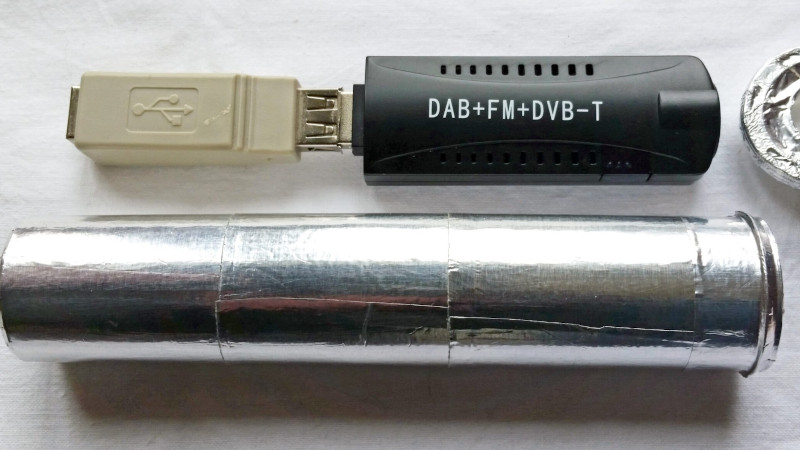Even though not every Hackaday reader is likely to be a radio enthusiast, it’s a fair guess that many of you will have experimented with an RTL-SDR USB dongle by now. These super-cheap devices are intended for digital TV reception and contain an RTL2832 chip, which with the proper software, can be pushed into service as a general purpose software defined radio receiver. For around $10 USD they’re fantastic value and a lot of fun to play with, even if they’re not the best radio ever. How to improve the lackluster performance? One of the easiest and cheapest ways is simply to shield it from RF noise, which [Alan R] has done with something as mundane as a tubular fizzy orange tablet container.
This is probably one of the simpler hacks you’ll see on this site, as all it involves is making an appropriate hole in the end of the tube and shielding the whole with some aluminium foil sticky tape. But the benefits can be seen immediately in the form of reduced FM broadcast band interference, something that plagues the cheaper dongles.
Perhaps the value in this hack aside from how easy it is on a cheap dongle is that it serves to remind us some of the benefits of paying a little extra for a better quality device. If you’d like to know more about RTL-SDR improvements, it’s a topic we covered in detail back in 2019 when we looked at seven years of RTL-hackery.
















I did the same just with an rectangular sweets box. added extension cable to get away from computer noise too, and a real sma jack
How about using an aluminum soda/beer can? One can add heat fins to the outside to radiate waste heat with that. If one only opens one end of the can for inserting the dongle, the unit can even sit in a water/ice bath…
Or the venerable Pringles Can (of ‘cantenna’ fame. And I guess it comes with crisps inside as a bonus), a cardboard tube as in OP’s setup, but pre-aluminised.
At least you get a sharp and crisp(y) reception, depending on the Pringles’ flavor.
Will a metal cigar tube work?
If you have one of the cheap generic RTL-SDR devices, the shielding will help. But if you’re buying new, you should spend the extra money for one of the enhanced dongles from RTL-SDR Blog or Nooelec that already has shielding and a TCXO.
While the RTL-SDR v3 got me into the hobby, it’s pretty horrible, images everywhere, easily overloaded. It’s best to just save up and get a better SDR like something from SDRPlay or Airspy, you’ll be a lot happier with the results.
The whole, or the hole? Is the entire thing being shielded with tape, or just the end that the socket is sticking out of?
Yep!
Uh, don’t take this with you on a plane…
Challenge accepted!
Make sure to write down your last wills before…
From some experimenting, I’ve been having pretty good luck printing shields using conductive filament. I’m shielding emissions rather than reception. Your attenuation may vary.
OK. Please tell: What kind of filament is conductive enough to have a reasonable skin depth to provide shielding with tolerable wall thickness? I have genuine uses for that, but can’t find any remotely good enough (not by a few orders of magnitude).
MIG wire.
Too bad. My extruder does not get hot enough for MIG filament.
Duct tape the business end of a MIG welder in there.
Learn from my mistake. A 120V MIG is generally too weak. Get the good inverter based one or regret your purchase.
What about those USB isolator devices?
Galvanic insulation of USB would be nice, too.
The PC is a source of noise, too! 🙂
Caution: The cheap USB isolator devices only support USB 1.1, but for SDR you really want/need the speed of USB2 (or 3 if supported by the device)!
Is there any need for the metal foil to be connected to a ground point, or would the trick work anyway ?
Like any other Faraday cage, there is no need to ground the shield to function *as a shield*.
However, it’s not a completely closed box — it has wires going in and out: It’s likely that an ungrounded shield will end up at a different potential than the RF ground that enters or exits it. In that case, the foil shield will act a bit like an antenna, because it has voltage (noise) on it that differs from the RF signal’s ground reference, and that potential can capacitively couple with the circuitry inside, inducing noise on that circuit.
A foil shield not solidly connected to the RF ground *might* help, might be better than nothing, but also might act like a really good noise antenna if you get the geometry right (wrong). Better to make a good connection to the RF ground reference (like the SMA body).
does it increases its performance?